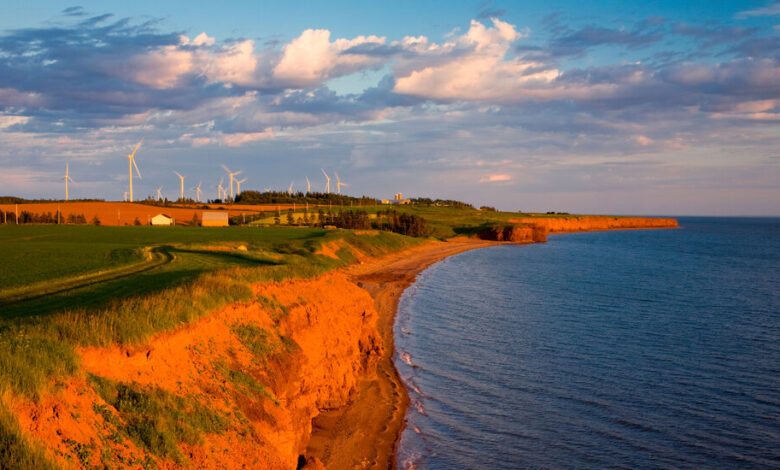
[ad_1]
Human bones were found protruding from the side of an eroding cliff on Prince Edward Island in Canada late last month.
But it wasn’t a crime scene. The remains, discovered by a resident who was out for a walk along the province’s western coast, were most likely from a shipwreck that occurred roughly 150 years ago.
It is also possible that the bones had been previously found and reburied, said Scott Ferris, a spokesman for the Royal Canadian Mounted Police in Prince Edward Island. Hurricane Fiona, he added, caused erosion and damage to the island in 2022, raising the possibility that more such remains could be found.
The authorities came to the conclusion that the bones were most likely from a shipwreck largely by speaking with locals familiar with the island’s history and by reviewing historical accounts, said Cpl. Gavin Moore, another spokesman for the R.C.M.P. in Prince Edward Island.
While an investigation is ongoing, Corporal Moore said it was unlikely that the bones were connected to any recent events.
But if local experts agree that a shipwreck is the most likely scenario, it raises a question: Which one?
Unfortunately, we will probably never know. There were simply too many wrecks in the area, many of which have been lost to history.
During the Age of Sail — a period from the 16th century through the 19th century when ships with sails were commonly used for trade, travel and war — the seas around Prince Edward Island saw a lot of traffic. Ships would come from New England to fish (cod and, later, mackerel). Others came for the flourishing timber trade.
As a result, there were hundreds of shipwrecks around the island, said Edward MacDonald, a history professor at the University of Prince Edward Island. Not all those wrecks were documented at the time, and many have been lost to history.
For Prince Edward Island, the Age of Sail peaked between 1840 and 1880, when more than 3,000 wooden sailing ships were built on the island, Professor MacDonald said.
“If in fact the bones are from a shipwreck,” he said, “it speaks to the marine history of P.E.I. and its location in the middle of a major shipping lane.”
While bones are a relatively rare find on the island, remnants of wrecks show up regularly, Professor MacDonald, who used to work for the P.E.I. Museum and Heritage Foundation, said in a telephone interview.
“Almost every year, some gale exposes the remains of a shipwreck on P.E.I.,” he said. The reason, he added, is that “individual wrecks happened all the time. Plus, vessels get abandoned. It’s like abandoned cars.”
Some storms stand out in the history of the province. The Yankee Gale in October 1851, for instance, caused at least 74 shipwrecks and 150 fatalities.
It’s unlikely, however, that the remains that surfaced late last month were from any of those wrecks, because they were found on the other side of the island, Professor MacDonald said.
The area where the bones were found, in West Cape on the western side of the island, has been perilous for ships, according to John Cousins, a folklorist who has written a book about the island’s history.
“There, the reef is shallow and dangerous,” he said. “The waters driven by tide and wind get very rough and a sailing vessel, drawing perhaps 10 or 12 feet of water could ground there.”
Mr. Cousins, who was born and raised on Prince Edward Island, said in an email that he remembered a time when there was “no running water, no electricity, very few telephones and very few cars.” He said he went to his first movie “by horse and wagon.”
People who died in shipwrecks would often be buried near the shore, rather than in a cemetery.
“With two feet of erosion per year, they would simply be washed away,” Mr. Cousins said. “That sort of thing has been common at West Cape for generations.”
The chance of more such discoveries is likely as the coast continues to erode and sea levels rise.
“I just think there’s probably more bones to be revealed yet as erosion occurs,” Paul Wood, who lives atop the cliff where the bones were found, told the CBC.
It’s not the first time human remains were found in the area, officials said. There were similar discoveries in 2002 as well as in the 1950s and ’60s, according to Corporal Moore, the police spokesman.
But the discovery of any remains or remnants from shipwrecks sends a ripple of interest across the island every time it happens.
“I am still surprised when it happens now because the cape has eroded hundreds of feet in some places,” Mr. Cousins said.
Professor MacDonald said that these discoveries open a window into a vanished past, though they usually leave people with more questions than answers. But that can spark the imagination, he added, prompting people to fill in the story themselves.
“And who,” he said, “doesn’t love a good story?”
Source link




